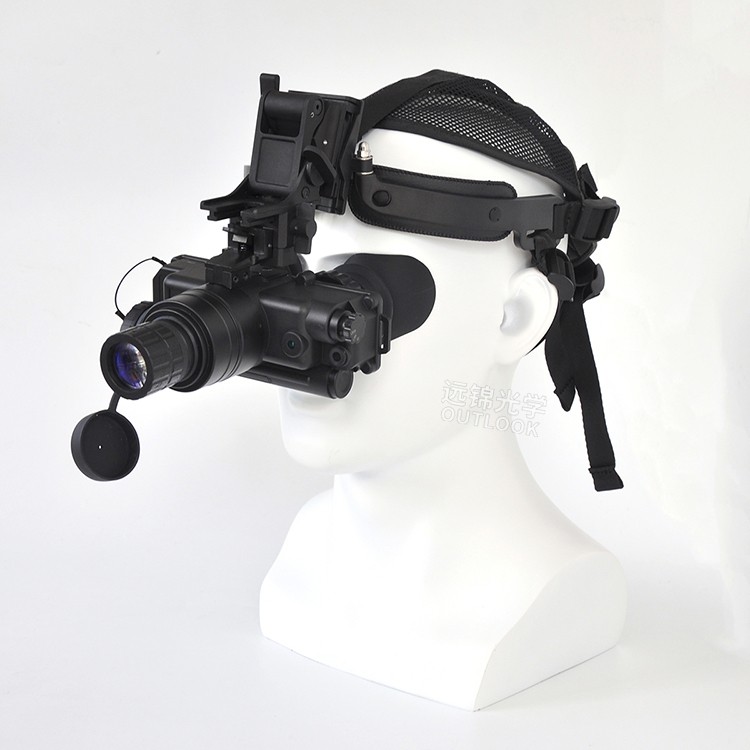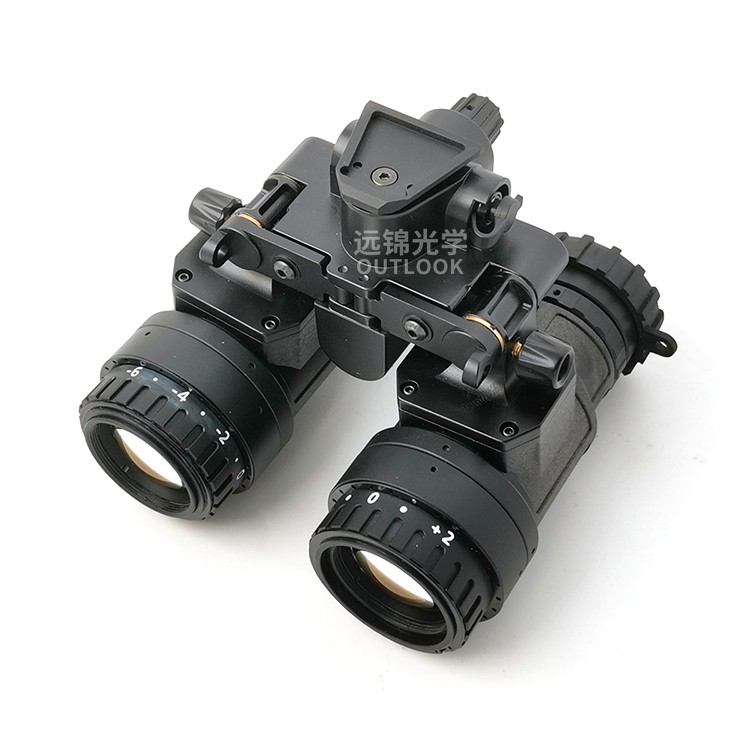Benefits of Binocular Night Vision Devices
Excellent observation comfort and immersion
Stereoscopic vision and depth perception: These are the core advantages of night vision binoculars. Each eye simultaneously sees independent images, which the brain fuses to create a strong sense of three-dimensionality and precise depth perception. This makes judging distance, terrain relief, and object relationships highly intuitive and accurate, significantly reducing misjudgments.
Significantly Reduced Eyestrain: This system conforms to the natural human habit of binocular vision, making it less likely to cause headaches, nausea, or eye fatigue, unlike monoculars, even after prolonged use.
Wider Overall Field of View and Better Situational Awareness
While the field of view of a single objective lens in a monocular and binocular setup may be similar, binoculars, through two parallel channels, offer a wider, more natural "seeing the world through a window" experience. This provides enhanced peripheral vision, improves situational awareness at night, and makes it easier to spot threats or targets to the side.
Better Image Quality and Performance
High-end binoculars, such as the YJ-GPNVG-18, typically feature an ultra-wide field of view (e.g., 97°). Even standard binoculars, due to their high-end positioning, typically use image intensifier tubes (IITs) with specifications (resolution, signal-to-noise ratio, and quality) that generally surpass those of comparable monoculars.
Higher stability and adaptability
More comfortable and balanced headwear: When mounted on a helmet, the weight of night vision binoculars is distributed centrally on the forehead, making them more stable and comfortable than side-mounted monoculars (which require counterweights for balance). They are also better suited for extended wear and high-speed movement.
More suitable for dynamic activities: With their excellent depth perception and stability, binoculars are an absolute top choice for dynamic missions such as night hunting, patrolling in complex terrain, and operating vehicles or aircraft.
Disadvantages of binocular night vision goggles
High cost
This is the primary disadvantage. Binoculars are often twice or more expensive than monoculars because they require two high-performance IITs, a more sophisticated optical system, and a more complex construction. Top-of-the-line holographic waveguide binoculars (such as the GPNVG-18) are even more expensive.
Heavier and Larger
Despite continuous design improvements, binoculars are inherently heavier and larger than monoculars. They're not as convenient to carry and store as a monocular, and they place more strain on the neck (although they're better balanced when worn on the head).
No Dark-Adapted Eye Retention
When using binoculars, both eyes must be looking through the binoculars, preventing one eye from adapting to the dark as with a monocular. Sudden bright light (such as enemy lighting or muzzle flash) can blind both eyes, requiring longer recovery time. However, modern, high-end binoculars often feature autogating and bright light protection to significantly mitigate this issue.
Less Flexibility
While they can be handheld, they were designed primarily for headwear. They're not as quick to remove from a bag and use as a monocular. Removing them from a helmet and handing them to a teammate to share vision is also less convenient than with a monocular.
Binocular night vision goggles are ideal for the following users and scenarios:
Professional Users: Special forces, law enforcement, search and rescue teams, and others who conduct long, intense nighttime missions. Advanced enthusiasts and hunters: Those seeking the best nighttime experience, engaging in nighttime hunting and expeditions, and with a sufficient budget.
Activities requiring depth perception: Any scenario requiring rapid movement, driving, or judging jumps or climbs at night.
Users with high comfort requirements: Those who cannot tolerate the visual fatigue of a monocular and plan to use the device for hours.
In short, binocular night vision devices offer unparalleled viewing comfort, immersion, and operational effectiveness at the expense of higher cost and larger size. They are the ultimate choice for users seeking a one-stop solution and optimal performance, while monoculars are more of a cost-effective entry-level or backup option.

Advantages of Binocular and Monocular Night Vision Devices
Significantly Improved Comfort
Binocular Viewing: This is their core advantage. Users can view a single image with both eyes simultaneously, significantly reducing the eye strain, headaches, and nausea associated with monocular viewing. They are far more comfortable for extended use than monoculars.
Better immersion and situational awareness
Although it doesn't offer the stereoscopic vision of true binoculars, binocular vision provides a wider field of view and less obstruction of peripheral vision, offering a better sense of immersion than a monocular, making it easier for the user to immerse themselves in the environment.
Perfect balance of cost and weight
Cheaper than true binoculars: Because it uses only a single image intensifier tube and a primary optical system, its cost is significantly lower than true binoculars, which require two separate systems.
More comfortable than a monocular: It offers near-binocular comfort at a significantly lower cost.
Good head balance
Due to its binocular design, the weight distribution is generally more centered and stable than a side-mounted monocular (which requires additional weights), making it more comfortable when worn on a helmet.
Disadvantages of binocular night vision devices
Lack of stereoscopic vision and depth perception
This is their most fundamental limitation. They still provide a single, flat image, viewed by both eyes simultaneously. The brain cannot process the two independent images of true binoculars to create true stereoscopic perception and accurate depth perception. It still has difficulty judging distance and terrain height differences.
Performance ceiling limited by a single tube
All of its performance (resolution, gain, signal-to-noise ratio) depends on the single image intensifier tube. True binoculars typically use two higher-specification tubes to achieve ultimate performance.
Size and weight larger than a night vision monocular
While lighter than true binoculars, the housing and binocular lens design are necessarily larger and heavier than a compact monocular, sacrificing portability.
No dark-adapted eye retention
Like true binoculars, both eyes are used during use, preventing one eye from maintaining dark adaptation to cope with bright light, as is the case with a monocular.
Binocular and monocular night vision devices are ideal for the following users and scenarios:
Budget-constrained advanced enthusiasts: Those who cannot afford the high price of true binoculars but cannot tolerate the fatigue of using a monocular for extended periods of time find this the most cost-effective and comfortable solution. For users who need to observe static objects for extended periods of time, such as border patrol, security, and wildlife observation, comfort is a primary consideration.
A general-purpose compromise: For users seeking the optimal balance between cost, weight, and comfort.
In a nutshell:
Binocular and monocular night vision devices address the biggest pain point of monocular devices—comfort—at a significantly lower cost than true binoculars. However, they cannot address the other pain point of monoculars—the lack of depth perception.
It is a very practical and popular compromise between monoculars and true binoculars.

Summary of Types and Typical Scenarios
Choose a Binocular/Monocular Night Vision Device if:
You have a medium budget and want the best balance between cost and performance.
You cannot tolerate the visual fatigue of a monocular and plan to conduct long periods of continuous observation (such as overnight hunting and border patrols).
You need a head-mounted device and want good balance and immersion, but find the price of true binoculars prohibitive.
Typical Users: Serious hunting enthusiasts, security personnel conducting long-term surveillance missions, and outdoor enthusiasts who value comfort.
Choose a True Binocular/Monocular Night Vision Device if:
Budget is not a primary consideration, and you seek ultimate performance.
You need to maneuver at high speeds, in complex terrain, or drive at night, and rely on powerful stereo vision and depth perception to ensure safety and efficiency.
You work in professional fields such as law enforcement, tactical operations, and search and rescue, requiring the utmost reliability and situational awareness. Typical Users: Professional military/law enforcement units, experienced night hunters, and budget-conscious enthusiasts.
Important Note: Generation is Key
After deciding on the type of image intensifier tube, the generation (Gen) of the image intensifier tube is a more crucial factor in determining image quality and price. For example, a Gen 3 night vision monocular will far outperform a Gen 1+ night vision binoculars in low-light performance.
Gen 1: Basic, requires minimal ambient light, is suitable for close range, and is inexpensive.
Gen 2/Gen 2+: Offers good performance and is a good value option.
Gen 3: The current mainstream high-end, with excellent performance and exceptional performance in extreme low-light environments, but comes at a premium.
Final Recommendation:
For most serious hobbyists, a Gen 2+ or Gen 3 night vision binocular/monocular night vision device is often the most practical and balanced choice. It solves the biggest comfort problem of monoculars at an acceptable cost and provides performance that is sufficient in most scenarios.
night vision night vision night vision
night vision night vision night vision night vision night vision night vision

